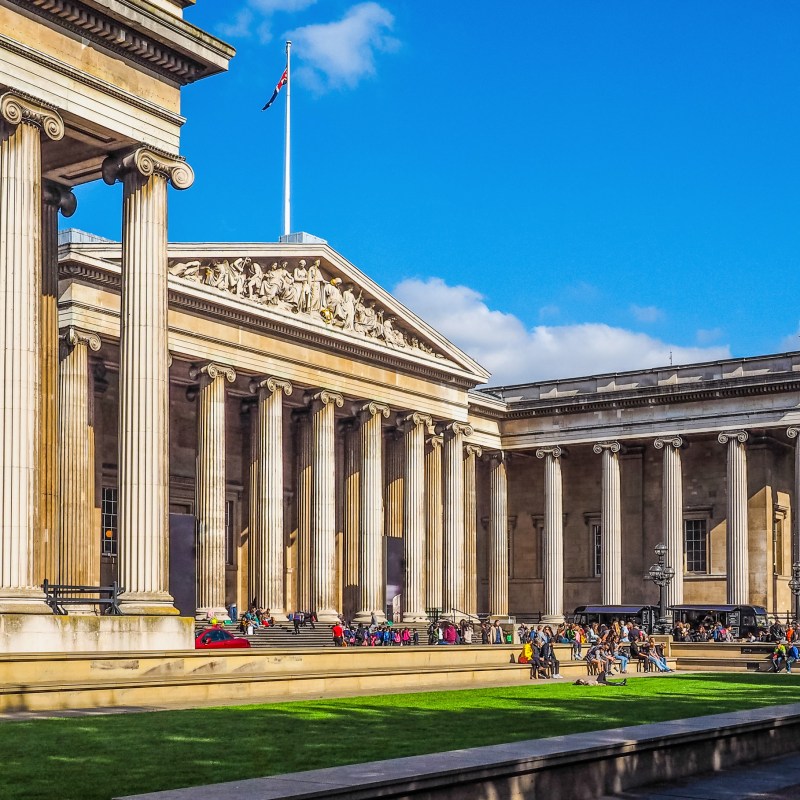
It’s easy to ride the Tube or a bus from King’s Cross St. Pancras Station to the British Museum, but you see more on foot. The direct route is about one mile with no hills.
Videos by TravelAwaits
From King’s Cross, the route traverses Bloomsbury, famous for writers, artists, and green squares.
Guided tours are often organized along a theme. Our list is not like that. It follows a fairly direct route and shows you some points of interest along the way.

The Magnificent Architecture Of King’s Cross St. Pancras
King’s Cross St. Pancras is two connected train and Tube stations, with shopping, food, and restrooms inside each.
Witnessed from across busy Euston Road, the two stations are distinctly different. King’s Cross was designed by engineer Lewis Cubitt and opened in 1852. It looks boldly modern. Two great train-sized arches proclaim its purpose.
In contrast, the front of St. Pancras International Station, designed by Sir George Gilbert Scott, is a highly decorated red brick Gothic Revival masterpiece. Today, this is the front of the St. Pancras Renaissance London Hotel, formerly the Midland Grand Hotel, built in 1873.

Argyle Square, From Dust Heap To Respectability, Twice
The neat Georgian terrace houses defining Argyle Square today don’t give any clues to its dirty past.
The ground between here and King’s Cross Station used to be covered in the literal dirt of the Great Dust Heap. Pigs roamed this garbage mountain, hunting for food. Human scavengers sifted for valuables. Even dead cats were worth retrieving for their fur.
The story is that the Russians bought this dust heap and others to make into bricks for rebuilding Moscow after Napoleon burned it down.
Starting in the 1840s, Argyle Square saw the building of nice new homes. They weren’t meant to be grand, just tasteful, respectable houses.
Things slid downhill in the 20th century. King’s Cross became notorious for crime, prostitution, and drug dealing.
Since the 1990s, investments in the station and area have raised the tone again.

A Taste Of Art Deco In Bloomsbury
Clare Court on Judd Street in Bloomsbury is a U-shaped art deco apartment building with a spacious feel. Its most colorful past resident may have been Ian D. A. Board.
From the 1940s until he died in 1994, Board worked at and then ran the dingy, legendary Colony Room Club in Soho. The artist Francis Bacon was a regular.
Christopher Howse wrote that in a court case, Board gave his address as Clare Court. Then he testified about throwing the mobile phone of one Babyface Scarlatti across the room at the club.
Howse’s obituary of Board said, “In his 60th year he gave up drinking brandy for breakfast. He drank vodka in the morning at home.”

The First Medical School For Women, 8 Hunter Street
The extraordinarily determined Sophia Jex-Blake and six other women were admitted to study medicine at the University of Edinburgh in 1869. Many male classmates and doctors opposed them, even staging a riot. In 1873, those women who had already been granted degrees saw them revoked under pressure from the men.
In 1874, the determined Jex-Blake leased a house at 30 Handel Street (formerly Henrietta Street) and started a medical school. The London Evening Standard printed two sentences about it, beginning, “The London School of Medicine for Women was opened without any special ceremony.” The next story, significantly longer, featured the annual oyster festival in Colchester.
The school was a success, and in 1898 moved to a new, purpose-built home at 8 Hunter Street. Now used as a health center, the building continues along Handel Street and up Wakefield Street. Above the main door is the old sign, “London Royal Free Hospital School of Medicine for Women”.

St. George’s Gardens, Outdoor Space For The Poor
This is one of London’s secret gardens. It’s no coincidence that St. George’s Gardens used to be an overgrown cemetery. Peeking in here will add about 15 minutes to your walk.
In 1714, this became the first London cemetery set far away from its church. The churchyards in London were full and this was the only solution.
After this new space was itself filled up, it became neglected.
As Charles Dickens vividly documented, London in the 1800s was a hard place for poor people. A few decades after Dickens, social reformers led by Miranda and Octavia Hill campaigned for more green space for Londoners. Opening up the cemeteries as public parks was one strategy. St. George’s Gardens opened as a park in 1884 and was one of the sisters’ first successes.
The high brick walls were built to keep out the body snatchers of the 1700s. These criminals sold stolen bodies to anatomists.
On the other side of the south wall is The Foundling Museum, but there is no direct public access to it.
Notable people remembered inside the cemetery-turned-park include Oliver Cromwell’s granddaughter Anna Gibson, whose large tomb is fairly easily found. On the north wall, there’s a plaque honoring 16 Jacobite supporters of Bonnie Prince Charlie, who were all executed in 1746 and buried here.
Leave St. George’s Gardens the way you came.

The Foundling Museum, Brunswick Square
A visit to The Foundling Museum will take you off the direct path and is worth a stop of an hour or more if you have time. Otherwise, save it for another day and use Handel Street or Hunter Street to reach the nearby Brunswick complex (a large concrete building).
The Foundling Museum tells the story of the Foundling Hospital. Distressed by the suffering and death of abandoned babies in London, sea captain Thomas Coram and many influential supporters started a charity in 1739. The Foundling Hospital wasn’t a hospital for the sick; it was an orphanage that cared for children until 1954.
In the museum, visitors learn about the children’s lives. There are recordings of some of the people who grew up in care telling their own stories.
Many people are moved to see the tokens that the desperate, often destitute, mothers of the 1700s used to leave with their babies to identify them later, if ever they could reclaim them. The hope embodied in a playing card torn in half or a faded scrap of ribbon is timelessly touching.

Skoob Books In The Brunswick
Having been home to Virginia Woolf and Charles Dickens, among many other writers, it’s no surprise to find bookstores in Bloomsbury. Skoob is eclectic and accommodating, described by Time Out magazine as a “temple for secondhand books”.
Skoob is in The Brunswick, a modern concrete mixed-use complex from the early 1970s that combines apartments, shopping, and a cinema.
Leaving The Brunswick will put you on Marchmont Street. The local Marchmont Society has put up their own blue plaques on buildings associated with famous past residents. Kenneth Williams, comic actor, was one.

The Horse Hospital, Colonnade
The Horse Hospital, built in 1797 when horses were the engines of transport, became an independent arts venue in the 1990s.

Kimpton Fitzroy London Hotel
Formerly the Hotel Russell, this hotel in Russell Square is eclectic and decorated to the extreme. The front of the hotel has statues of four past English queens.

Russell Square
Inside Russell Square, it’s leafy and green with a playful fountain.
On the western corner, outside the green space, there is a little green building. This is a traditional cabmen’s shelter, originally meant just for taxi drivers but now open for anyone to buy food and drink.
From here, it’s a short walk to the British Museum.
Pro Tips: The entrance on Montague Place may be quicker to get in through than the main entrance. To explore Bloomsbury more deeply, consider booking a tour with a London Blue Badge Guide.
For more unique London experiences, consider these eight things to do in the Marylebone neighborhood, what to know about mudlarking on the River Thames, and why you should visit the Churchill War Rooms.
